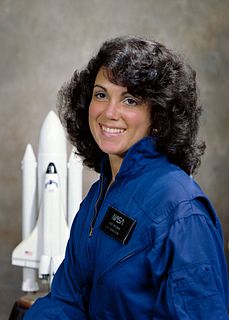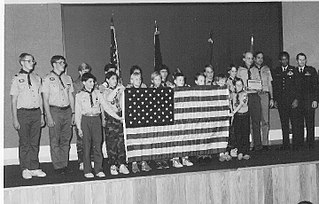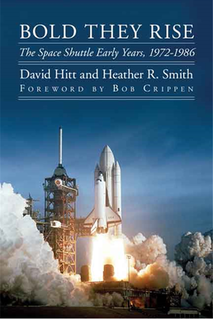
Space Shuttle Discovery is one of the orbiters from NASA's Space Shuttle program and the third of five fully operational orbiters to be built. Its first mission, STS-41-D, flew from August 30 to September 5, 1984. Over 27 years of service it launched and landed 39 times, aggregating more spaceflights than any other spacecraft to date. The Space Shuttle launch vehicle has three main components: the Space Shuttle orbiter, a single-use central fuel tank, and two reusable solid rocket boosters. Nearly 25,000 heat-resistant tiles cover the orbiter to protect it from high temperatures on re-entry.

Triskaidekaphobia is fear or avoidance of the number 13. It is also a reason for the fear of Friday the 13th, called paraskevidekatriaphobia or friggatriskaidekaphobia.

The Space Shuttle program was the fourth human spaceflight program carried out by the U.S. National Aeronautics and Space Administration (NASA), which accomplished routine transportation for Earth-to-orbit crew and cargo from 1981 to 2011. Its official name, Space Transportation System (STS), was taken from a 1969 plan for a system of reusable spacecraft of which it was the only item funded for development.

The Space Shuttle Columbia disaster was a fatal incident in the United States space program that occurred on February 1, 2003, when the Space ShuttleColumbia (OV-102) disintegrated as it reentered the atmosphere, killing all seven crew members. The disaster was the second fatal accident in the Space Shuttle program, after the 1986 breakup of Challenger soon after liftoff.

Rick Douglas Husband was an American astronaut and fighter pilot. He traveled into space twice: as Pilot of STS-96 and Commander of STS-107. He and the rest of the crew of STS-107 were killed when Columbia disintegrated during reentry into the Earth's atmosphere. Husband is a recipient of the Congressional Space Medal of Honor.

Judith Arlene Resnik was an American electrical engineer, software engineer, biomedical engineer, pilot and NASA astronaut who died aboard the Space Shuttle Challenger when it was destroyed during the launch of mission STS-51-L. Resnik was the second American woman in space and the fourth woman in space worldwide, logging 145 hours in orbit. She was the first Jewish woman of any nationality in space. The IEEE Judith Resnik Award for space engineering is named in her honor.

The Space Shuttle Challenger disaster was a fatal incident in the United States' space program that occurred on January 28, 1986, when the Space ShuttleChallenger (OV-099) broke apart 73 seconds into its flight, killing all seven crew members aboard. The crew consisted of five NASA astronauts, and two payload specialists. The mission carried the designation STS-51-L and was the tenth flight for the Challenger orbiter.

STS-61-A was the 22nd mission of NASA's Space Shuttle program. It was a scientific Spacelab mission, funded and directed by West Germany – hence the non-NASA designation of D-1. STS-61-A was the ninth and last successful flight of Space Shuttle Challenger. STS-61-A holds the current record for the largest crew - eight people - aboard any single spacecraft for the entire period from launch to landing.

STS-27R was the 27th NASA Space Shuttle mission, and the third flight of Space Shuttle Atlantis. Launching on 2 December 1988 on a four-day mission, it was the second shuttle flight after the Space Shuttle Challenger disaster of January 1986. STS-27R carried a classified payload for the U.S. Department of Defense, ultimately determined to be a Lacrosse surveillance satellite. The vessel's heat shielding was substantially damaged during lift-off, impacting the right wing, and crew members thought that they would die during reentry. This was a situation that was similar to the one that would prove fatal 15 years later on STS-107. Compared to the damage that Columbia sustained on STS-107, Atlantis experienced more extensive damage. However, this was over less critical areas and the missing tile was over an antenna which gave extra protection to the spacecraft structure. The mission landed successfully, although intense heat damage needed to be repaired.

Rendez-vous Houston: A City in Concert was a live performance by musician Jean Michel Jarre amidst the skyscrapers of downtown Houston on the evening of April 5, 1986, coinciding with the release of the Rendez-Vous album. For a period of time, it held a place in the Guinness Book of Records as the largest outdoor "rock concert" in history, with figures varying from 1 to 1.5 million in attendance. Rendez-vous Houston is remembered for being the concert which celebrated the astronauts of the Space Shuttle Challenger disaster, which had happened only two and a half months earlier. One of Jarre's friends, astronaut Ron McNair, had been killed in the disaster. He was supposed to play the saxophone from space during the track "Last Rendez-Vous"; his substitute for the concert was Houston native Kirk Whalum.

Paul Sean Hill was the Director of Mission Operations at the NASA Lyndon B. Johnson Space Center in Houston, Texas. He was formerly a Flight Director in the Mission Control Center for Space Shuttle and International Space Station missions under the call sign "Atlas".

The Challenger flag is an American flag that was placed in the flight kit of Space Shuttle Challenger for mission STS-51-L. The flag was sponsored by Boy Scout Troop 514 of Monument, Colorado, whose Scoutmaster was William "Bill" Tolbert, a major in the United States Air Force assigned to the Space Command.

Space Center Houston is a science museum which serves as the official visitor center of NASA Johnson Space Center in Houston. It earned a place as a Smithsonian Affiliate museum in 2014. The organization is owned by NASA and operated under a contract by the nonprofit Manned Spaceflight Education Foundation, a 501(c)(3) organization. The Johnson Space Center is the home of Mission Control and astronaut training.
Criticism of the Space Shuttle program stemmed from claims that NASA's Shuttle program failed to achieve its promised cost and utility goals, as well as design, cost, management, and safety issues. Fundamentally, it failed in the goal of reducing the cost of space access. Space Shuttle incremental per-pound launch costs ultimately turned out to be considerably higher than those of expendable launchers. By 2011, the incremental cost per flight of the Space Shuttle was estimated at $450 million, or $18,000 per kilogram to low Earth orbit (LEO). In contrast, the comparable Proton launch vehicle is said to cost as little as $110 million, or around $5,000 per kilogram to LEO, despite not being reusable.
The National Intelligence Medal of Achievement is an award that was presented to members of the United States Intelligence Community, both civilian and military, to recognize significant acts of service to the community as a whole. The National Intelligence Medal of Achievement was replaced with the equivalent National Intelligence Exceptional Achievement Medal, during the restructuring of the National Intelligence Community Awards (NICA) Program, with the revision of Intelligence Community Directive 655 in 2012.
Jarvis was a proposed American medium-lift launch vehicle for space launch, designed by Hughes Aircraft and Boeing during the mid-1980s as part of the joint United States Air Force (USAF)/National Aeronautics and Space Administration (NASA) Advanced Launch System (ALS) study. Intended to utilize engines and tooling in storage from the Saturn V rocket program along with Space Shuttle components, and projected to be capable of carrying up to six satellites into multiple orbits using a single launch, the proposal failed to meet the ALS requirements, and the Jarvis rocket was never built.

Jay Barbree is a retired correspondent for NBC News, focusing on space travel. Barbree is the only journalist to have covered every non-commercial human space mission in the United States, beginning with the first American in space, Alan Shepard aboard Freedom 7 in 1961, continuing through to the last mission of the Space Shuttle, Atlantis's STS-135 mission in July 2011. Barbree was present for all 135 Space Shuttle launches, and every manned launch for the Mercury, Gemini, and Apollo eras. In total, Barbree was witness to 166 human space launches.

STS-135 was the 135th and final mission of the American Space Shuttle program. It used the orbiter Atlantis and hardware originally processed for the STS-335 contingency mission, which was not flown. STS-135 launched on 8 July 2011, and landed on 21 July 2011, following a one-day mission extension. The four-person crew was the smallest of any shuttle mission since STS-6 in April 1983. The mission's primary cargo was the Multi-Purpose Logistics Module (MPLM) Raffaello and a Lightweight Multi-Purpose Carrier (LMC), which were delivered to the International Space Station (ISS). The flight of Raffaello marked the only time that Atlantis carried an MPLM.

Bold They Rise: The Space Shuttle Early Years (1972-1986) is a 2014 non-fiction book by David Hitt and Heather R. Smith. Bold They Rise tells the story of the Space Shuttle through the personal experiences of the astronauts, engineers, and scientists who made it happen—in space and on the ground, from the days of research and design through the heroic accomplishments of the program to the tragic last minutes of the Space Shuttle Challenger disaster.
















